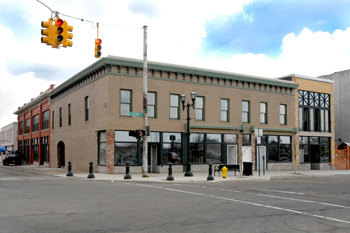 The latest chapter in the up-and-down history of Pontiac's Crofoot Building, one of its oldest downtown structures, will begin when it reopens as a concert venue on Sept. 6th.
The latest chapter in the up-and-down history of Pontiac's Crofoot Building, one of its oldest downtown structures, will begin when it reopens as a concert venue on Sept. 6th.
The Crofoot’s latest chance at life comes thanks to Blair McGowan, a local preservationist who has rehabbed a number of historic downtown Pontiac structures including Clutch Cargo's. Vacant, boarded up and run down, the Crofoot stared demolition square in the eye as recently as 2005. Until McGowan stepped in with the idea of restoring the building to its 1850s state.
"It's now geared up for another 100 years of service," McGowan boasts.
With the help of a $100,000 Cool Cities grant, the Crofoot will reopen as a live-performance venue with a 1,000-person capacity, similar to St. Andrews Hall in downtown Detroit. It will also house two corner bars and a pool hall at the southeast corner of Saginaw and Pike streets while maintaining many of its historical features, such as old wood beams.
“Pontiac is the fourth oldest and one of the most historic towns in Michigan,” McGowan says. “It's just full of beautiful, historic buildings.”
This is far from the first time the Crofoot has undergone major work. The building has experienced its own tragedies and rebirths since its construction in the 1830s. Many nearby structures in the surrounding commercial district burned in 1840, but the Crofoot survived. Because of that fire all subsequent buildings in the district were built of masonry.
 Michael E. Crofoot renovated the structures on the southeast corner of Pike and Saginaw, including the Crofoot, in 1882. He re-used foundations, floors and walls and renamed the resulting building after himself.
Michael E. Crofoot renovated the structures on the southeast corner of Pike and Saginaw, including the Crofoot, in 1882. He re-used foundations, floors and walls and renamed the resulting building after himself.
Crofoot was a prominent businessman; county probate judge and attorney who helped build the Soldiers and Sailors Monument in downtown Detroit. Pontiac’s Crofoot School, which is still in use, was also named after his family.
The Crofoot building underwent a number of exterior modifications throughout most of the 20th century that resulted in the loss of most of its Victorian-era details, including the third floor Mansford roof and adjacent tower. It was combined with two smaller adjacent buildings during World War II into the structure it is today.
Urban renewal projects in the 1970s, which were in a rush to tear down numerous historic structures, nearly doomed the Crofoot. However, it was spared while the area southwest of Saginaw and Pike Streets and much of the historic property south of the Clinton River were razed for what was seen at the time as “progress.”
The building continued to decline and by 2005 it had been vacant for nearly a decade. The city condemned the property and scheduled it for demolition just before McGowan came to the rescue. He now plans to keep the historic name “Crofoot” in his new businesses there, the “Crofoot Café” and the “Crofoot Ballroom”.
"Maintaining these historic buildings can invoke a sense of value in people's lives because it's more permanent than the latest news cycle or fad," McGowan says.
Source: Blair J. McGowan, owner of the Crofoot Building
Writer: Jon Zemke
Enjoy this story?
Sign up for free solutions-based reporting in your inbox each week.